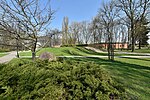Gdański Bridge
Bridges completed in 1959Bridges in WarsawDouble-decker bridgesEuropean bridge (structure) stubsPoland transport stubs ... and 4 more
Polish building and structure stubsRoad bridges in PolandTruss bridgesWarsaw building and structure stubs

The Gdański Bridge (Polish: Most Gdański) is a six-span steel truss bridge, 406.5 m long and 17 m wide, across the Vistula in Warsaw, Poland. It opened on 31 July 1959 after three years of construction. It has two decks: the upper deck carries a four-lane road with sidewalks, while the lower one has two tram tracks, a cycle lane and a footpath. The bridge was built upon the supports of the Citadel Rail Bridge which had been destroyed during World War II. In 1997-1998 the bridge underwent reconstruction. It was painted green and the lower level was fitted with colour bulbs for illumination at night.
Excerpt from the Wikipedia article Gdański Bridge (License: CC BY-SA 3.0, Authors, Images).Gdański Bridge
Wybrzeże Helskie, Warsaw Praga-Północ (Warsaw)
Geographical coordinates (GPS) Address External links Nearby Places Show on map
Geographical coordinates (GPS)
| Latitude | Longitude |
|---|---|
| N 52.260555555556 ° | E 21.009166666667 ° |
Address
Most Gdański
Wybrzeże Helskie
00-221 Warsaw, Praga-Północ (Warsaw)
Masovian Voivodeship, Poland
Open on Google Maps











